The Salar (Salt Flats)
19 December, 2007, 09:01 am in "Bolivia"
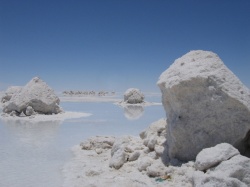 DAY 1
DAY 1Our tour of the Salar de Uyuni, the largest salt flats in the world, and vicinity started this morning. By 10 the sun was shining and the day looked beautiful-- a relief after the downpour the night before. We had scheduled our trip with Jenette, a woman from Norway studying in Buenos Aires, with whom we also went on the mine tour with. We ran into her again on the bus to Uyuni. Also at the office was Pippa, from Australia who had been volunteering in Urubamba for 3 months. We were missing 2 more people who were supposed to have arrived from La Paz in the morning.
We left anyway and went to visit the train cemetery which was one of the sights in town: a patch of land covered with rusting locomotives and piles of scrap metal.
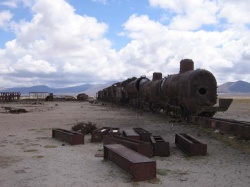
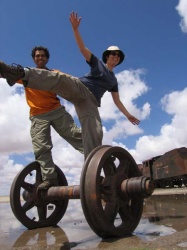
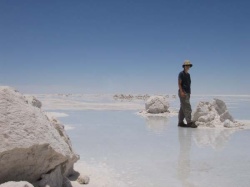
We swung back by the office but the 2 other members of our group still hadn't appeared so we went to Colchani: a tourist trap of a town with a few salt block buildings, stores selling souvenirs and "museums" of large kitchy salt sculptures. While we were wandering around, another jeep from our tour agency pulled up bringing Fred and Marisa, whose bus had gotten stuck in a river for 4 hours on their way from La Paz.
We started seeing the stretches of white and eerie combinations of mirage and reflections from quite a ways off.
I had been worried that since we were getting into the rainy season we'd miss seeing the magnificent expanses of crystallized salt. As it was, I think we got here at the perfect time. The tour company told us the downpour of the previous night had been the first heavy rain of the season. The Salar would be crossable for about a week, then there would be too much water to reach the Isla de Pescado. We had enough water on the flats to create beautiful hallucinogenic reflections of mountains, "islands", people and cars. Yet, there were also the great expanses of white salt, dried and crystallized into honeycomb patterns.
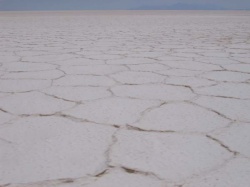
The Salar is a huge flat area that shifts between unmeasurable spaces of sparkling white and other shimmering sections where the water creates a perfect mirror of sky and islands. It's hard to judge spaces. It's hard to tell where the sky ends and the earth begins. Looking off in the distance it seems you are approaching a lake with a building or car floating on it. Then the lake shimmers into non-existence as you near it, fading into a mirage. Other times there really is water which looks like it is a sea but in reality is only a centimeter deep. Islands and mountains rest on perfect reflections of themselves and seem to float in the sky.
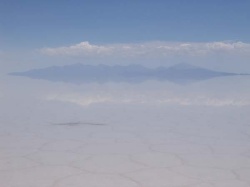
People seem to be walking on water. On a grand scale the snow-looking salt, dissolving into reflections on the edges seems magical, beautiful and peaceful. It is also a little frightening since it feels like being in a huge desert where you can't be sure what is real and what is a mirage.
In the middle of the Salar is the Isla de Pescado. Iit seemed to float in the sky.
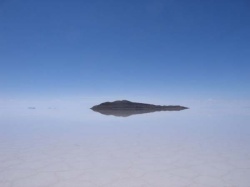
As we got closer we could see tall cacti, looking unworldly in the middle of what resembled a frozen lake. The island has paths and is made up of rocks that resemble a coral reef. In reality they are volcanic rock but viewing the "coral arch"
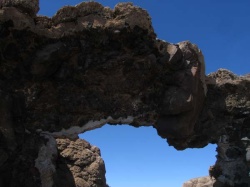
it was easy to imagine fish swimming around the rocks. The island offered a stunning 360 degree view of the Salar as well as a volcano with a huge crater blown out of the top.
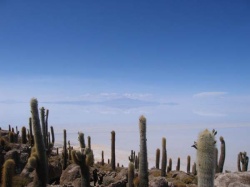
We ate lunch at tables made of salt
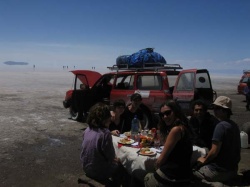
and then continued across the salt flats to get to the village where we'd spend the night. That night we had a delicious dinner and some unique musical entertainment provided by local children. Rowshan couldn't resist joining in.
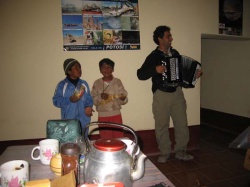
The hostel was in front of a field full of llamas (and/or alpacas)
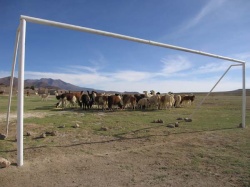
However, in the morning the llamas had to give the field back to the children so they could play soccer.
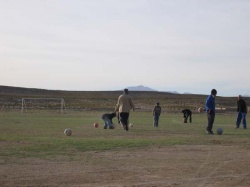
DAY 2
As we reached our first stop this morning, the Salar de Chiquana, a white field of salt surrounded by red volcanoes, I thought how this area might be the most desolate place I've ever seen.
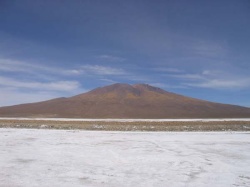
The salt coats the ground so no plants can grow. It looks like snow. The treeless volcanoes, some with huge craters blown from the tops, rise from an otherwise flat landscape. The mountains are above the treeline so are barren. There was a cold wind and with the snow looking salt, it felt like it was in the Arctic somewhere. Even the earth crunched as if it was frozen (though actually it was just extremely dry).
We continued on to a mirador where we could see several volcanoes including Volcan Ollague which had a small plume of steam rising from it although it has been dormant for 100 years. The mirador was an outcropping of volcanic rock. There were a few scraggy bushes and large round mossy plants which resembled green coral.
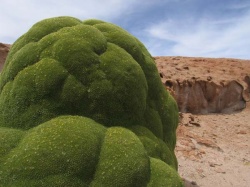
Perched on one of the rocks was a viscacha. It ran and jumped from rock face to rock face looking like a gravity defying kangaroo.
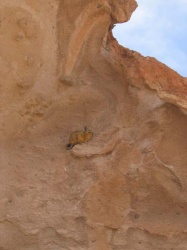
For lunch we stopped at a lake which was full of flamingos. The lake was murky with mineral deposits but the flamingos seemed happy. It was wonderful to see flamingos with their natural pink color and non-clipped wings.
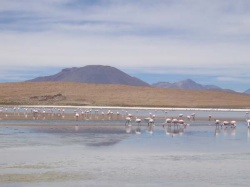
Up the hill we found a couple foxes, one apparently quite used to tourists. It leisurely sat in the parking lot waiting for the leftovers from tour group lunches.
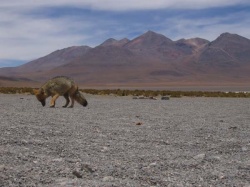
For such a desolate, harsh environment, it is amazing that we've seen so much life.
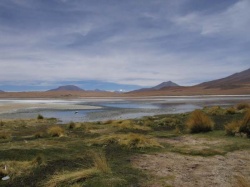
I guess since it is so harsh, humans have stepped aside--no villages, or industry-- and the animals thrive: viscachas, vicunas (animals from the end of the alphabet living at the end of the world), ostriches, flamingos and other birds, foxes and mice.
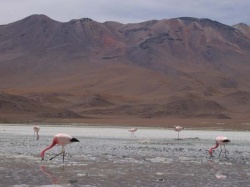
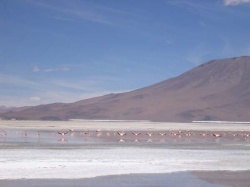
After lunch we drove on through long stretches of flat lands, surrounded by volcanoes
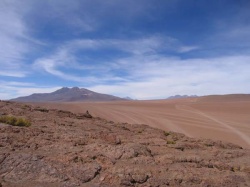
, and occasionally broken by outcroppings of rocks. It struck me that the landscape looked like artist's renditions of Mars, which I'd seen--flat with red, grey, white and yellow volcanoes. We passed by other lakes with masses of sulfur deposits and water colored by minerals.
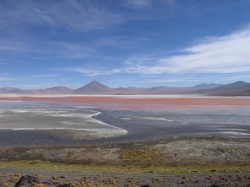
The flamingos stood in the small patches of water not filled with deposits, sometimes walking across white sulfur/salt deposits with their long legs. Another stop was an outcropping of rock called the Arbol de Piedra (Tree of Stone).
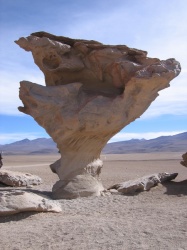
At Laguna Colorado, large patches of the water was rust colored. The afternoon brought strong winds, yet multitudes of flamingos stood on one leg, completely oblivious to the gusts. A herd of alpacas grazed by the lake.
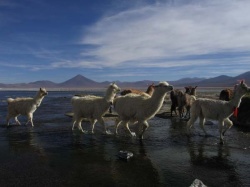
DAY 3
Valero, our guide, woke us all up around 4:30 AM. We had been forewarned (and I secretly hoped it was just a prank). We were all staying in one room and had finished off a couple bottles of wine the night before while playing a silly card game called Pig. We did go to sleep early (the electricity was only on for a couple hours until 9:30 PM).
We crawled out of our beds and put on several layers of clothing. It was freezing outside but thankfully, the winds of the night before had ceased. We piled into the jeep, racing to get to the geysers to watch the sunrise.
We could smell the sulfur before we could see the area. Soon the billows of steam became visible. We made it in time and got to see (and feel) the sun rise over the hill, shining through the clouds of steam.
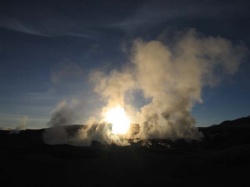
The "Geysers" aren't really geysers but rather fumaroles and boiling mud pits. However, they still are interesting.
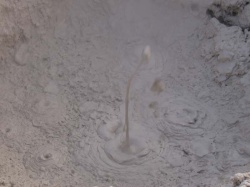
There were also some pools of mineral colored water.
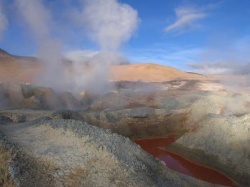
There were sulfur and other deposits on the ground around the fumaroles and inside, you could see the water and mud fiercely boiling.
Our next stop was the hot springs where we would get a warm bath and breakfast. The hot springs were mostly natural--a stone wall had been built to enclose them but the complete structure was built inside the lake.
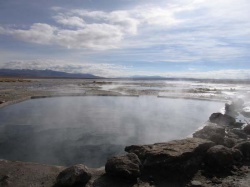
Algae covered rocks and sand made up the bottom. The water felt wonderful and it was hard to face the cold and get out. But we had a tight schedule: 13 hours on the road to get back to Uyuni by evening.
After breakfast, we went to Laguna Verde (green). We'd seen multi-colored lakes in the region--Blanco (white), Colorado (red)-- but I think Laguna Verde was the most beautiful. It was a turquoise green which was set against red mountains.
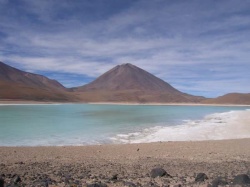
The whole area was filled with intense colors but the lake shone like an inlaid jewel. There were only a few flamingos in this lake and they stood out brilliantly against the green. Valero informed us that this was the most poisonous of all the lakes we'd seen. Its beautiful color was cuased by arsenic which also crystalized into white foam which covered the beaches and floated like miniature icebergs in the lake.
On the way back to the hot springs we passed a strange desert named "The Salvador Dali Desert" due to its resemblance to a Dali painting.
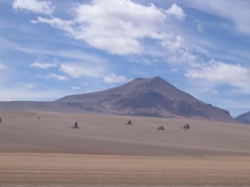
We also passed a pile of stones which someone had dressed up in a jacket. Rowshan joked that it was Dali painting, since it seemed to be looking at the desert.
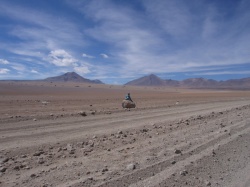
There was a lot of driving and although the scenery was beautiful, it felt long. We descended enough that we got some larger bushes. Our gradual approach to civilization was marked by more llamas and alpacas.
We had lunch in Villa Mar, a village with striking rock cliffs and a tiny bit of river passing through. The center looked like it was built for Munchkins with a tiny church, bandstand, and statue of a condor. A bit beyond was a rock cliff and a rather strange tail of an airplane.
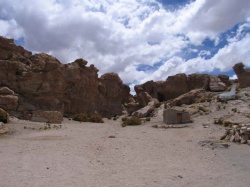
Our main stop of the afternoon was the Valle de Rocas. It was very reminiscent of Arches National Park (though on a much smaller scale) with red rock pillars, windows and huge cracks where slabs of the rock had tumbled to the ground.
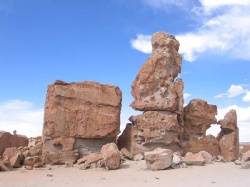
We passed a few villages and more llamas and alpacas. Valero had to honk whenver he came close to a herd crossing the street.
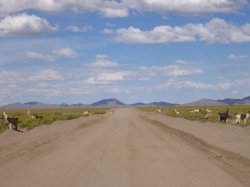
I was delighted when I realized they had yellow llama crossing signs.
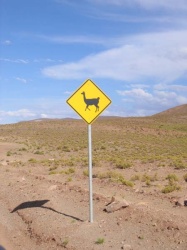
We breezed through San Cristobal to get back to Uyuni by 7. We were tired and dusty (and salty... and sulfury) but it had been an incredible trip and fortunately, Uyuni has some of the best pizza in Bolivia.
Comments
- Comments
Powered by My Blog 1.69. Copyright 2003-2006 FuzzyMonkey.net.
Created by the scripting wizards at FuzzyMonkey.net..
(Code modified by Rowshan Dowlatabadi)
Created by the scripting wizards at FuzzyMonkey.net..
(Code modified by Rowshan Dowlatabadi)

